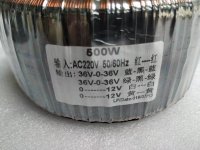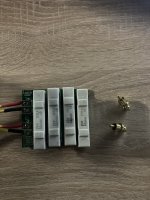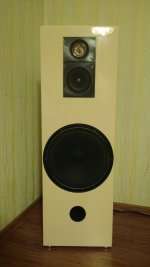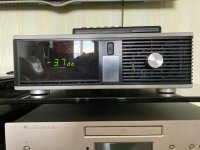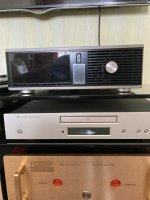No! I was takling about connecting input to the source of signal - not ground to the case. But first disconnect ground from the case.... connect the ground to the case ...
On the A60, nothing hangs on the case now (when I put the boards with relays, it is possible to ground them from the volume controls through resistors of 10 ohms each channel separately), the KRELL preamplifier has an input ground on the case.🙂
What is the purpose of these boards with relays?the boards with relays
If these boards with relays are for speaker protection you don't need them because the amplifier itself has own speaker protection circuit. Also note that ground of the amplifier is the first terminal next to the speaker output.
Next week I will put A60 boards back on the bench and make proper grounding so perhaps I can replicate your problem and hopefully indicate solution to the problem.
Cheers and pleasant Sunday afternoon.
Dear Berlusconi, these boards are the so-called Nikitinsky relay volume control, as I wrote, controlled by a controller with a display. Its power supply has a soft start for a power transformer, protection against a constant component in the 230v network and temperature protection, as well as various settings and opportunities. I give a link to the forum, I think you can read the translator for review. Do you think this is a problem when the ear is close to the speaker and the hiss is barely audible? 🤔 🙂
Probably not, it is more likely to be grounding problem. But, when solving the problem try to eliminate all unnecessary complexities. If you really need to attenuate the input signal use a fixed resistor or a potentiometer instead of that complex thing with multiple relays.Do you think this is a problem when the ear is close to the speaker and the hiss is barely audible?
Also: do you have separate two 12V transformers for speaker protection circuits? You need either two small transformers or a single transformer with double separate two 12V secondary windings. A single 12V transformer common for the both channels creates noise.
Try to be systematic: first try just one channel simply connected to the main transformer and speaker protection transformer. If this works, then try connecting just the other channel. Then continue with both channels connected simultaneously. You need first to allocate the source of the problem. Also, do all tests with the minimum bias settings. 20mV at the "test" points.
Good luck!
I will get back to you in the second half of the next week.
The relay volume control is good, better than ALPS, I’m not using it for the first time, especially since there is a lot that can be implemented on the controller, everything cannot be described here. Transformer with separate windings. I wrote that at the moment grounding does not affect the noise, then when I assemble it to the end, I will experiment.😉
Attachments
Your transformer is entirely adequate, channels are separated so no wories about possible interactions among the channels. I have a similar configuration: two separate toroid transformers and a separate 12VDC transformer with two separate secondaries.There is no noise at all on 97db speakers. Also measurements indicate low noise. However, input must be connected to good signal source. I have mine connected either to a DAC or a signal generator from my oscilloscope. In that case there is no noise at all. Nothing, like disconnected from electricity.The relay volume control is good, better than ALPS, I’m not using it for the first time, especially since there is a lot that can be implemented on the controller, everything cannot be described here. Transformer with separate windings. I wrote that at the moment grounding does not affect the noise, then when I assemble it to the end, I will experiment.😉
I do all the measurements on load resistors of about 8 ohms, instead of acoustics, and plugs at the inputs. After setting the quiescent current to 20mV, I connect the speakers in an hour. I can barely hear the hiss in my ear in the tweeter. Grounding is not yet connected anywhere. But I temporarily soldered the wire to the case from the negative terminals of the inputs - there were no changes, which indicates a good layout of the boards. I think so, please fix it.
Attachments
Hello everyone. I finished 90 percent of the A60. It remains to install temperature sensors and paint, bring the case back to normal. I can confidently recommend the amplifier for repetition. The sound is useless to describe, for this money - a bomb. I think this assembly will shake anyone for $ 3,000 or more.😉
Attachments
I will add. I switched it on directly from a simple CD player, no preamplifier or tone block needed. Pink Floyd plays like I'm at a concert.

Great news dear friend,I will add. I switched it on directly from a simple CD player, no preamplifier or tone block needed. Pink Floyd plays like I'm at a concert.
Over the past weeks I had numerous obligations and left aside my work on A60.
However, over the weekend I have made comparisons with several other amplifiers, including Krell KSA 50 and JLH. According to my measurements A60 beats them all, convincingly. Therefore, I understand perfectly your pleasure with the sound quality.
Very soon l will complete both my A60 and A60+ projects and will also present some photos.
Дружественные приветствия
Berlusconi I'm waiting for comments from all my friends, in reality he plays at +60, until I can distinguish from dartzil. Maybe friends will distinguish.
Attachments
I have a JLH headphone, and a KRELL, this one will overpower everyone, I have an excellent darts, it is a tube one and this driver is drop dead.
A60 is much better than the DartZeel NHB-108 clone. Measurements indicate that as you increase the power of NHB-108, THD goes up high and it has both even and od harmonics.@Berlusconi I'm waiting for comments from all my friends, in reality he plays at +60, until I can distinguish from dartzil. Maybe friends will distinguish.
In addition to that A60 has much wider bandwidth: from practically DC to several hunderd KHz. At low frequency, below 3 Hz speaker protection detects it as DC and opens the relay to protect the speaker. And it is stable and without slight phase shift.
I have both: completely with components from "reputable" supplier (Farnell) and "Finished" Chonese amplifier. This indicates that the Chinese components are of equal quality. In contrast to the gossip that everything from China must be fake. No that is a myth.
I listened to A60 for a long time, I like it more and more. I will give Dartzeel to my son.He has been asking for it for a long time.🤐
And by the way:
Your amplifier looks great. You could publish some photos in the sticky thread:
Post your Solid State pics here.
Your amplifier looks great. You could publish some photos in the sticky thread:
Post your Solid State pics here.
Good choice: youth needs something powerful for modern "distorted" music. 😉I listened to A60 for a long time, I like it more and more. I will give Dartzeel to my son.He has been asking for it for a long time.🤐
- Home
- Amplifiers
- Solid State
- A60(+) Amplifier. Build this?
